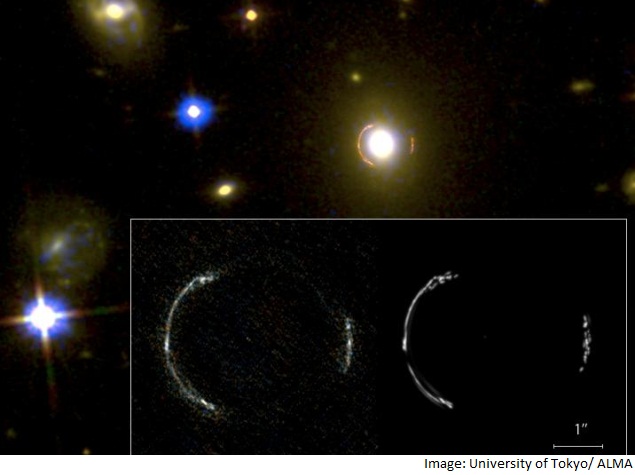In a first, Japanese astronomers have depicted a monstrous galaxy near the edge of universe with unprecedented detail.
The
monstrous galaxy called Session Description Protocol (SDP).81 is
located 11.7 billion light-years away from the Earth in the
constellation called Hydra. The researchers used the Atacama Large
Millimeter/submillimeter Array (ALMA) located in the Atacama desert,
northern Chile, with the assistance of a "natural telescope" known as a
gravitational lens.
The team modelled the lensing effects and
corrected them to reveal the distribution of huge stellar cradles in the
monstrous galaxy.
The same model, developed by Yoichi Tamura and
Masamune Oguri, assistant professors at the University of Tokyo, also
indicates the existence of a supermassive black hole at the centre of
the foreground galaxy.
Using their model, they corrected for
lensing effects and revealed that SDP.81 is a monstrous galaxy forming
stars at hundreds to thousands of times the rate, we see in the Milky
Way.
This is the first time astronomers have been able to reveal
the inner structure of such a distant galaxy. The model shows that the
fine structures in the ring reflect the inner structure of SDP.81.
Researchers
found that several dust clouds with sizes of 200 - 500 light-years are
distributed within an elliptic region 5,000 light-years across.
The
dust clouds are thought to be giant molecular clouds, the birthplaces
of stars and planets. The clouds in SDP.81 have sizes similar to those
found in our Milky Way and nearby galaxies
"This discovery is an
important step to understand the evolutionary process of starburst
galaxies and supermassive black holes in galaxies," the authors said.
The paper appeared in the journal Publications of the Astronomical Society of Japan.
 Amazon Great Summer Sale Starts May 1: Here Are the Top Smartphone Deals29 April 2025
Amazon Great Summer Sale Starts May 1: Here Are the Top Smartphone Deals29 April 2025 Samsung Galaxy S25 Edge Said to Be Equipped With Titanium Bezel, Corning Gorilla Glass Ceramic 2 Protection28 April 2025
Samsung Galaxy S25 Edge Said to Be Equipped With Titanium Bezel, Corning Gorilla Glass Ceramic 2 Protection28 April 2025 Samsung Galaxy S25 Edge’s Dummy Unit Surfaces in Hands-On Video; Size Comparable to iPhone 16 Plus28 April 2025
Samsung Galaxy S25 Edge’s Dummy Unit Surfaces in Hands-On Video; Size Comparable to iPhone 16 Plus28 April 2025 Samsung Galaxy Z Fold 7, Galaxy Z Flip 7 Launch Timeline Leaked; Said to be Thinner Than Existing Models28 April 2025
Samsung Galaxy Z Fold 7, Galaxy Z Flip 7 Launch Timeline Leaked; Said to be Thinner Than Existing Models28 April 2025 Hubble Captures Mars, Cosmic Nebulae, and Distant Galaxies in Spectacular 35th Anniversary Photos26 April 2025
Hubble Captures Mars, Cosmic Nebulae, and Distant Galaxies in Spectacular 35th Anniversary Photos26 April 2025

![Gadgets 360 With Technical Guruji: News of the Week [April 26, 2024]](https://c.ndtvimg.com/2025-04/5ucuv89c_news-of-the-week_160x120_26_April_25.jpg?downsize=180:*)













